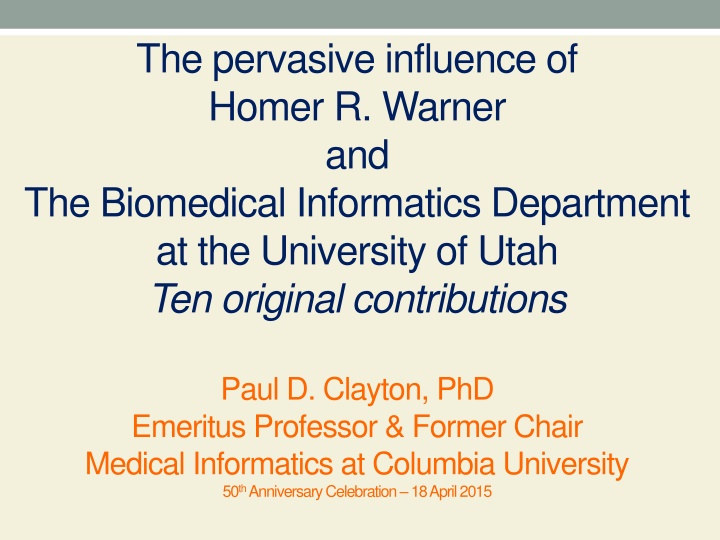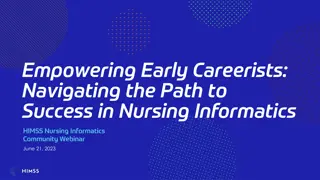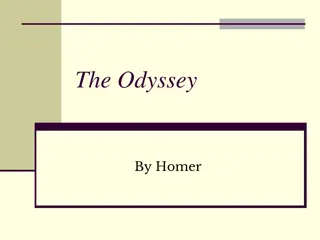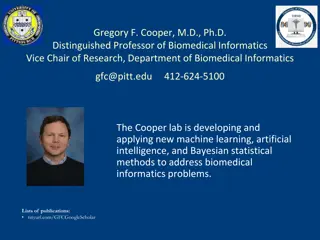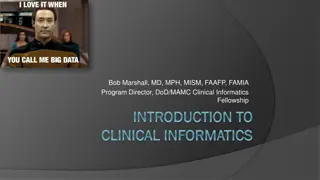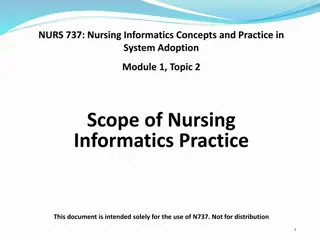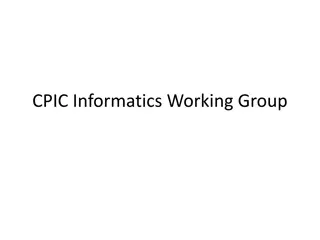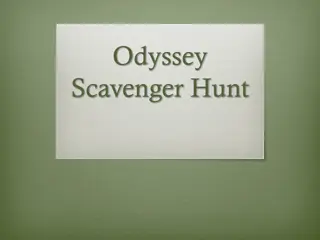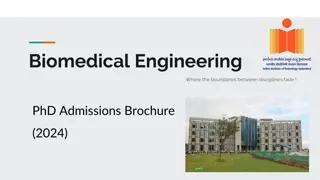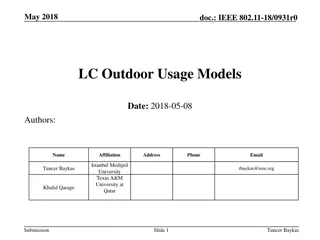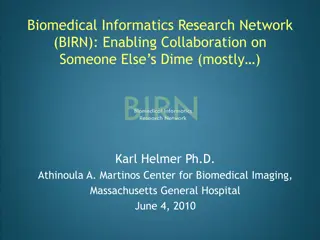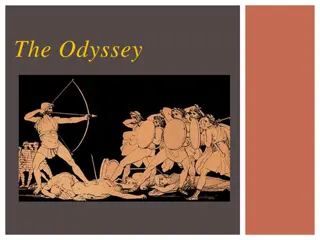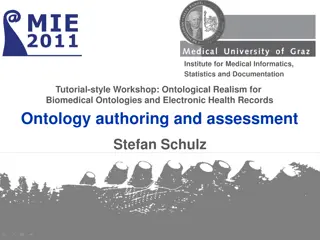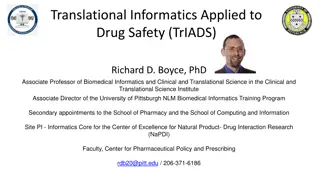The Pervasive Influence of Homer R. Warner and the Biomedical Informatics Department
The groundbreaking contributions of Homer R. Warner and the Biomedical Informatics Department at the University of Utah are highlighted, including the introduction of computerized systems for medical diagnosis, establishment of academic departments worldwide, development of expert systems in the 70s, and advancements in standards, interoperability, and database analytics over the decades. Their impact on areas such as clinical system architecture, radiology, data warehouses, and knowledge bases is emphasized, showcasing their pivotal role in shaping the field of medical informatics.
Download Presentation

Please find below an Image/Link to download the presentation.
The content on the website is provided AS IS for your information and personal use only. It may not be sold, licensed, or shared on other websites without obtaining consent from the author.If you encounter any issues during the download, it is possible that the publisher has removed the file from their server.
You are allowed to download the files provided on this website for personal or commercial use, subject to the condition that they are used lawfully. All files are the property of their respective owners.
The content on the website is provided AS IS for your information and personal use only. It may not be sold, licensed, or shared on other websites without obtaining consent from the author.
E N D
Presentation Transcript
The pervasive influence of Homer R. Warner and The Biomedical Informatics Department at the University of Utah Ten original contributions Paul D. Clayton, PhD Emeritus Professor & Former Chair Medical Informatics at Columbia University 50thAnniversary Celebration 18 April 2015
1958 Contract to computerize Index Medicus 1959 Reasoning foundations of medical diagnosis Ledly, Lusted Science 1961 A mathematical approach to medical diagnosis. Application to congenital heart disease. Warner HR, et. Al. JAMA Mid 60 s Creation of academic departments: US, France, Netherlands, Germany Installation of first user applications Signal processing Systemized Nomenclature of Pathology
70s Expert systems: DxPlain,Mycin,Internist, Operational applications: Regenstrief, HELP, DIOGENE, Kaiser, CT, MRI, Image processing 80 s Standards (HL7, UMLS, LOINC, SNOMED, ARDEN, GLIF, CEN TC 251) Commercial providers of systems Interoperability: FTP, e-mail, IAIMS 90 s WWW, (remote access) Natural Language Processing, PACS Database analytics 00 s Government incentives for use
1. Use of statistical probability in diagnosis: Bayes theorem Homer s 1961paper used real patient data and observed probabilities
2. Clinical System Architecture Data entry applications Clinical laboratory results PTXT Dictionary Rule evaluator Data up Retrieve HELP sectors Strato HCOM Patient Data
Radiology User Surgery applications literature Clinical Lab Interface engine Pathology Inference engine (CDSS) PACS vocabulary Genetic tests Data access modules Knowledge base Anesthesia Immunization Patient, provider & clinical database Insurance ... Data warehouse
CIS Component Model Data Warehouse MPI Repository Interface Engine Ancillary / Departmental Systems Clinical Applications CDSS RHIO HIE NwHIN Other Provider Organizations Knowledge Base Data Dictionary
3. Clinical Database structure Entity, attribute, value (type 2) Defined columns for each entity (type 1)
Even though technology has changed dramatically during the fifty years, The value of the clinical data is unchanged Punch cards vs voice input Software architecture and tools 2k program overlays vs unlimited memory Hardwired terminals vs hand-held WIFI Film vs digital imaging
4. Dictionary which defines terms stored in the database PTXT (pointer to text) UMLS The Metathesaurus forms the base of the UMLS and comprises over 1 million biomedical concepts and 5 million concept names, all of which stem from the over 100 incorporated controlled vocabularies and classification systems. Some examples of the incorporated controlled vocabularies are ICD- 10, MeSH, SNOMED CT, DSM-IV, LOINC, WHO Adverse Drug Reaction Terminology, UK Clinical Terms, RxNorm, Gene Ontology, and OMIM (Wikipedia).
5. Representing clinical Knowledge Declarative vs. Procedural HELP sectors Arden Syntax
6.Evoking medical logic Data driven - Asking for data input when the clinician is correct most of the time in order to catch the 2% of the time when there is a problem is off-putting. ask mode (differential diagnosis) information content Decision analysis (help sectors for probability and utility nodes)
Utility p3 Decision analysis Prostate cancer Cost +QALY p2 Impotent? Utility 1-p3 p1 Incontinent? 1-p2 Utility Survive? 1-p1 Utility Surgery? Utility p4 metastases hormonal yes 1-p4 Utility p5 Radiation? metastases Utility 1-p5 Utility hormonal p6 Metastase s Utility 1-p6 Utility
7. Population analysis STRATO find the population for whom a particular Help sector logic is true by applying that logic to every patient in the database
8. Genetic Markers Family pedigree Mark Skolnick 1974 Finger print analysis Isolated genetic markers (BRCA etc.)_
9.Evaluation of the impact of informatics Gardner, Evans, Haug ICU outcomes Drug alerts Infectious disease occurrence and control Quality outcomes and subsequent improvements
10. Student and faculty contributions Arden LOINC HL-7 Genetic markers UMLS Leadership: Study section, AMIA, ACMI academic departments, businesses, Healthcare organizations
